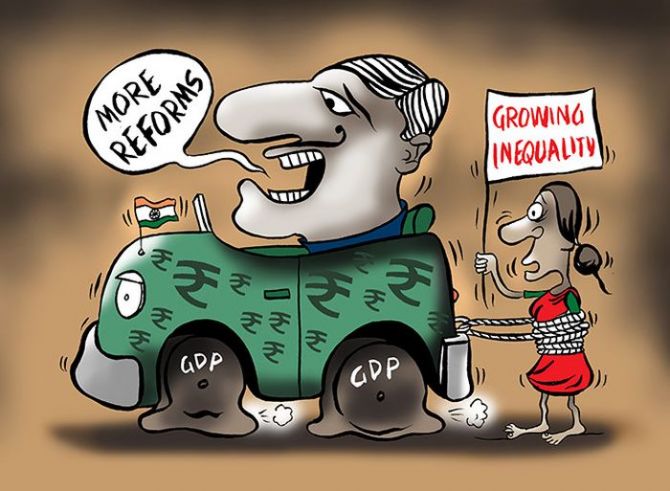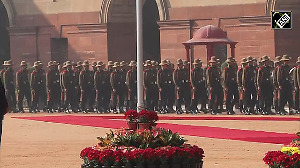'Milking poorly performing or easily marketable assets is the way to deliver more money for key programmes,' says T N Ninan.

Illustration: Uttam Ghosh/Rediff.com
There is a paradox at the heart of the Narendra Modi government’s five Budgets. Growing numbers of taxpayers have been coughing up vast sums as taxes, but government expenditure has grown all too little, and failed to keep pace with the growth of the economy.
The result is that key government programmes find their outlays barely keeping pace with inflation.
The heart of the problem with the Budget is not taxes, but the poor returns on past government investments. Yes, the public sector.
Take a look at the numbers.
Income tax collections in the last Modi Budget, compared to the last Manmohan Singh Budget, are expected to go up by 118 per cent, and gross tax revenue to double.
Both have handsomely outstripped economic growth, which over these five years is expected to be 67 per cent in nominal terms (real growth plus inflation).
Because of sharply increased tax transfers to states, which are set to grow over these five years by a stupendous 145 per cent, the Centre's net tax revenue grows more slowly but still at a good clip: 81 per cent.
Even this lower figure is not matched by central government spending, which is to go up by only 57 per cent -- slower even than the 67 per cent growth of GDP in this period.
Much more money is being collected as tax but, relative to the growing economy, the government is shrinking.
The problem lies with a bundle of items clubbed together as non-tax and capital receipts, which are to grow by a bare 20 per cent over five years.
The main items in this group include interest on loans given by the government, receipts from divestment and sale of radio spectrum to telecom companies, dividend payments by government companies, and borrowings to cover the deficit.
The only item that should be shrinking here is that last item, while milking spectrum for revenue has reached the end of the road.
If the government is to budget properly for under-funded sectors like education, if proper provisions are to be made for headline programmes like health insurance, and investment in core infrastructure is to be increased faster, then the non-tax part of government revenue has to grow.
As it is, some 85 different programmes that the government calls 'core', 'core of the core', and 'major' -- including such items as rural employment guarantee, highways, crop insurance, Swachh Bharat, and urban metro projects -- get between them a total outlay that is barely a fifth of the total central Budget.
The rest goes into government establishment expenditure, defence, interest payments, subsidies, and pensions.
Of these, defence and subsidies too have been squeezed in recent years.
Over the past quarter century, fitful tax reform has created a structure that is broadly what it should be.
All that needs to be done is some remaining reform of corporate taxes, rationalising the rates for the goods and services tax, and proper equalisation of capital gains taxation across all asset classes.
All three can be done quite easily in a phased manner. The underlying point is that, for an economy with India's level of per capita income, tax revenue as a proportion of GDP is where one would expect it to be.
Indeed, it has moved up from 10.1 per cent in 2013-2014 to a projected 12.1 per cent next year -- probably the highest it has ever been.
Demonetisation and the goods and services tax have helped.
The real task waiting to be tackled is a review of the entire portfolio of government assets -- primarily companies but also highway and other infrastructure projects that have been completed, and land.
This should be with a view to launching a more ambitious and multi-faceted privatisation programme, designed to churn the government's asset portfolio.
The money from sales should be used to finance investment in new infrastructure projects and other assets.
Milking poorly performing or easily marketable assets is the way to deliver more money for key programmes.











